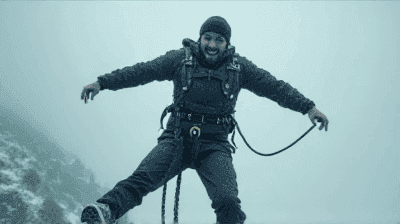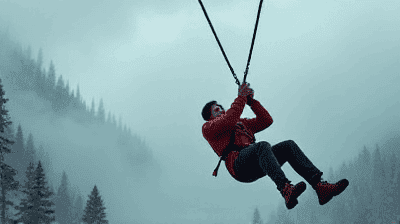

Bungee jumping, a thrilling extreme sport that involves leaping from a great height while secured to a large elastic cord, is popular among adrenaline seekers for its rush and excitement. But what happens when external conditions turn extreme? Many thrill-seekers will push the limits, testing the boundaries of their courage and the capabilities of their equipment by jumping in less-than-ideal weather. Whether it is howling winds, torrential rain, or the cold embrace of snow, bungee jumping in extreme weather presents unique challenges and risks.
Before delving into the effects of extreme weather on bungee jumping, it is essential to grasp the fundamental mechanics involved:
Bungee Cord and Harness: The bungee cord, typically made of latex or a combination of materials, is designed to stretch and absorb the energy from the jump. The harness secures the jumper and attaches them to the bungee cord, ensuring their safety.
Jump Dynamics: The dynamics of bungee jumping involve understanding the forces at play: gravity pulls the jumper downward, while the elastic properties of the bungee cord allow for a rebound effect. This interplay defines the jump experience.
Freefall and Rebound: During the initial drop, jumpers experience a sensation of weightlessness. The rebound phase occurs when the bungee cord reaches its maximum stretch and begins to retract, pulling the jumper back upward. This cycle continues for several bounces until the jumper comes to a gentle stop.
The safety of jumpers is of utmost importance in bungee jumping, and operators usually adhere to strict safety regulations. Instruments such as load cells measure the weight and force on the bungee cord, ensuring the equipment is functioning correctly. In challenging weather conditions, however, these standards must be re-evaluated and adhered to even more strictly.

Wind can significantly impact a bungee jump experience. Depending on its direction, intensity, and consistency, wind can alter the trajectory and safety of the jump. Here are some ways wind affects bungee jumping:
Lateral Movement: High winds can push jumpers off course during free fall, particularly if the jump site is on a bridge or tall structure. Lateral movement can result in a deviation from the intended landing zone, leading to a harsh impact or collision with obstacles.
Uncontrolled Swinging: Strong gusts of wind can disrupt the stability of the jumper during rebound, causing uncontrolled swinging movements. This instability can be disorienting and increase the risk of injury upon landing.
Equipment Stress: Wind can put additional stress on bungee cords and harness systems. Operators must ensure that equipment is rated for extreme conditions and is inspected thoroughly before jumps.
Jumping in windy conditions requires extra caution. Here are some recommended safety measures:
Pre-Jump Assessment: Operators should conduct a thorough assessment of wind speed and direction before allowing jumps. Most bungee operators have specific wind criteria dictating when jumping is permissible.
Equipment Checks: Ensure that all equipment, including the bungee cord and harness, is in optimal condition and rated for high-stress conditions.
Training for Jumpers: Jumpers should undergo proper training, learning techniques to minimize movement during the jump, such as adopting a streamlined position to reduce wind resistance.
Stories abound of jumpers who have experienced the thrill of leaping into windy conditions. Some recount feeling the wind push them momentarily off their intended path, adding an unexpected element of excitement to their jumps. However, such stories also serve as cautionary tales about the importance of respecting nature's unpredictable power.
Jumping in the rain presents unique challenges and risks that require careful consideration. Here are the primary effects:
Visibility Reduction: Rain can impair visibility for both the jumpers and the ground crew, increasing the likelihood of miscommunication or accidents.
Slippery Surfaces: Rain can make surfaces slippery, including the jump platform and the path to the launch point. This can pose a significant risk of slips or falls.
Temperature Considerations: Rain often brings cooler temperatures, which can increase body tension and affect the jumper's ability to relax during the fall.
Operating in rainy conditions requires specific precautions to ensure the safety of the jumpers:
Assessing Conditions: Operators should evaluate not only the intensity of the rain but also the possibility of lightning or thunder in the area. These environmental factors can significantly impact safety.
Equipment Considerations: All equipment should be checked for optimal function. Attention should be paid to how the rain may affect the integrity of the harness and cord.
Proper Footwear: Jumpers should wear footwear designed for wet conditions to minimize slips and falls.
Jumpers who have braved the rain share mixed feelings about their experiences. Many recall the adrenaline rush of jumping through the raindrops, describing it as a unique thrill. However, others emphasize the need for thorough safety measures, especially regarding visibility and footing.

Snow brings an entirely different set of challenges to bungee jumping:
Cold Temperatures: Snow and cold weather can constrict muscles and increase the risk of injury. Jumpers may find it difficult to maintain a relaxed posture during the jump, affecting their overall experience.
Visibility Issues: Snow can also reduce visibility significantly. Operators must be extra vigilant to ensure that both the jumper and crew can see clearly and communicate effectively.
Landing Surface Concerns: Snow can create variable landing conditions. Soft snow can cushion a landing, while icy patches might pose a risk of hard impacts.
When considering a jump in the snow, care should be taken to ensure the safety of all participants. Here are some tips for jumping in winter conditions:
Clothing Layering: Dress in multiple layers to maintain warmth and comfort. Insulated, moisture-wicking materials are ideal for maintaining body heat.
Checking for Ice: Jump sites should be assessed regularly for icy conditions. Operators must ensure that landings are both safe and appropriate.
Communication is Key: Ensure that all team members are in clear communication. With visibility reduced, signaling and clarity are essential for safety.
Despite the challenges, some jumpers find the experience of jumping in the snow to be exhilarating. Stories from the field recount the surreal feeling of free-falling through a flurry of snowflakes, giving a sense of being in a winter wonderland. However, they also stress the need for heightened caution and preparation.
It is essential to choose a reputable bungee jumping operator that has experience dealing with extreme weather. Look for operators who:
Have Solid Safety Protocols: Ensure they conduct thorough assessments of weather conditions prior to each jump.
Provide Training: Quality operators provide comprehensive training and guidance for jumpers.
Maintain High Standards: The company should consistently adhere to safety regulations and utilize well-maintained equipment.
Bungee operators with skilled and trained staff can make the difference between a safe jump and a risky endeavor. Trained personnel can assess conditions, maintain equipment, and communicate effectively with jumpers throughout their experience.

Bungee jumping in extreme weather can lead to some of the most memorable and thrilling experiences of your life, but it is not without its risks. Understanding how wind, rain, and snow affect a jump is crucial for anyone considering this adventure.
Whether the experience awakens your adventurous spirit or teaches a valuable lesson in respecting nature's forces, preparation and awareness of potential hazards are key components of bungee jumping in challenging weather conditions. Follow safety protocols, choose reputable operators, and ensure you are adequately prepared to embrace each jump, regardless of the elements that surround you.
As you prepare for your next adventure, remember that while extreme sports often push the limits of thrill and excitement, your safety should always come first. Equip yourself with knowledge, ensure that you are informed about the risks, and embrace the thrill of taking a leap into the unknown.
Copyright © 2024 Challenging XS. All rights by Challenging XS.